Seedlings out of flask
Including Coryanthes and Cymbidium
canaliculatum.
A
different deflask method for epiphytes & Jewel Orchids, to
prevent over watering.
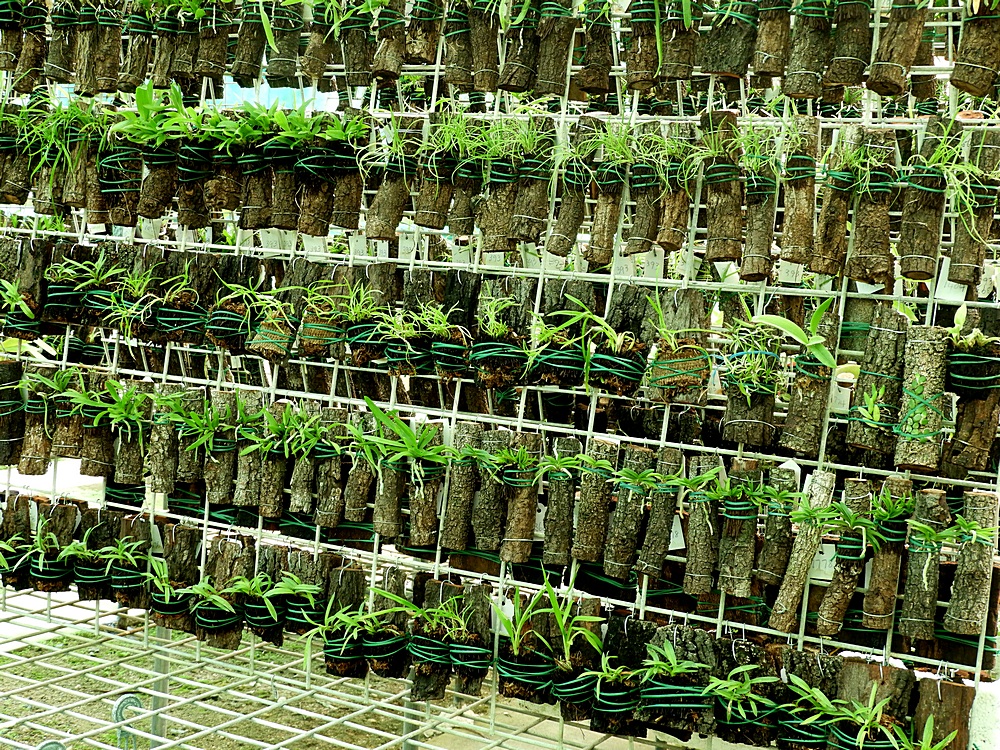
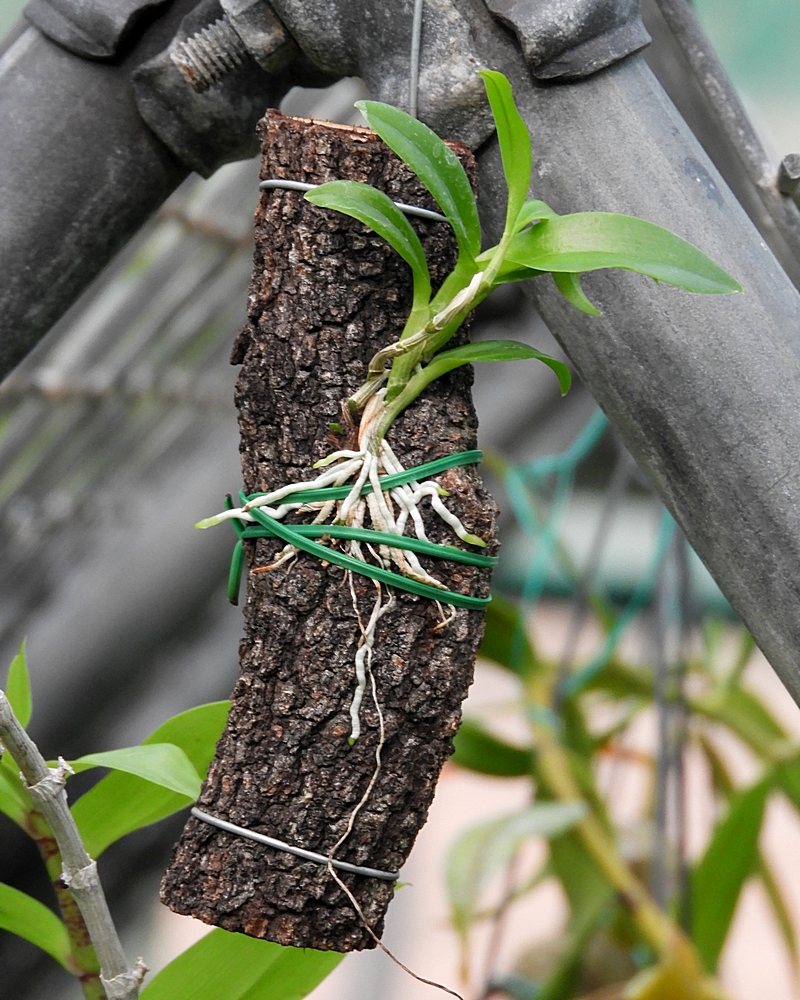 A
different deflask method; For all epiphytic species. we are using 10 cm pieces of iron bark, about 2.5 cm
diameter. Some with a little piece of treefern fibre under the seedling
or without. A
different deflask method; For all epiphytic species. we are using 10 cm pieces of iron bark, about 2.5 cm
diameter. Some with a little piece of treefern fibre under the seedling
or without.
This method has the advantage of being spray/watered twice a day without
the usual problem of over watering. Kept in a shady spot ( Phal
requirements) until well established. Fertilised weakly weekly. Photo
below Dendrobium about 3 weeks out of flask.
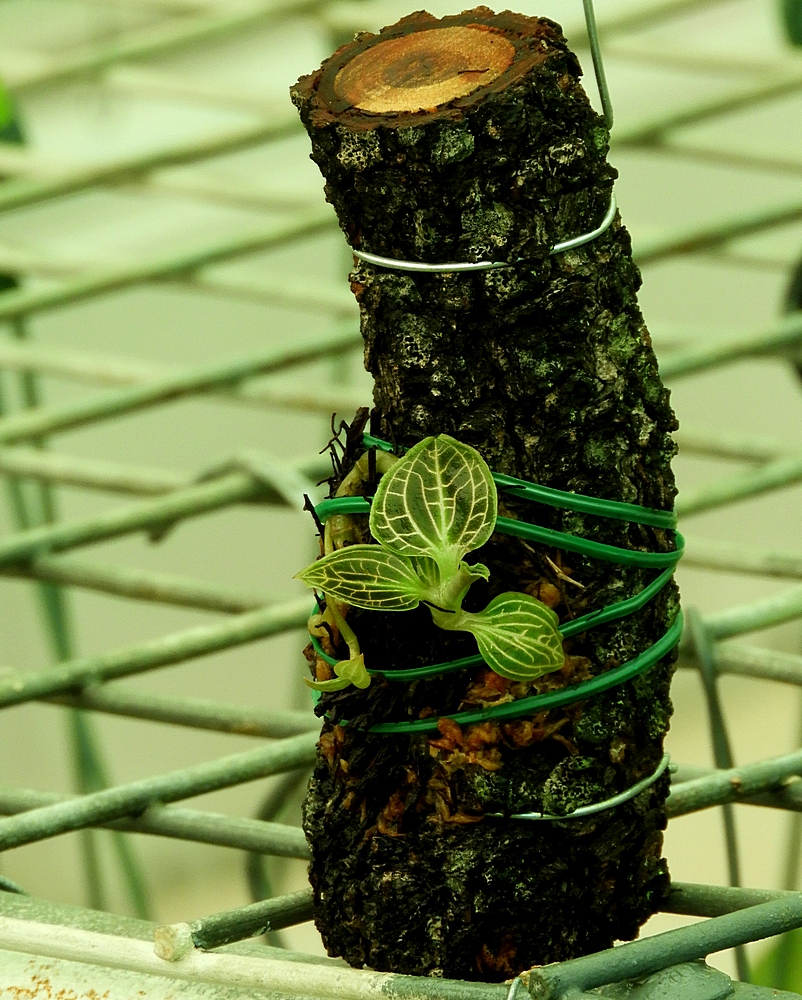 Jewel
Orchids. Grow
the seedlings ON something, not in a container. A thin bed of
spagh is placed on the mount, the seedlings are on top of the spagh and
a thin layer of treefern fibre or coconut coir, is placed over the seedling stems. This
eliminates the problem of over watering. This method can be applied to
Stanhopea, Catasetum, Coryanthes, Galeandra etc, with a little extra spagh moss to
make the growing ball. Jewel
Orchids. Grow
the seedlings ON something, not in a container. A thin bed of
spagh is placed on the mount, the seedlings are on top of the spagh and
a thin layer of treefern fibre or coconut coir, is placed over the seedling stems. This
eliminates the problem of over watering. This method can be applied to
Stanhopea, Catasetum, Coryanthes, Galeandra etc, with a little extra spagh moss to
make the growing ball.
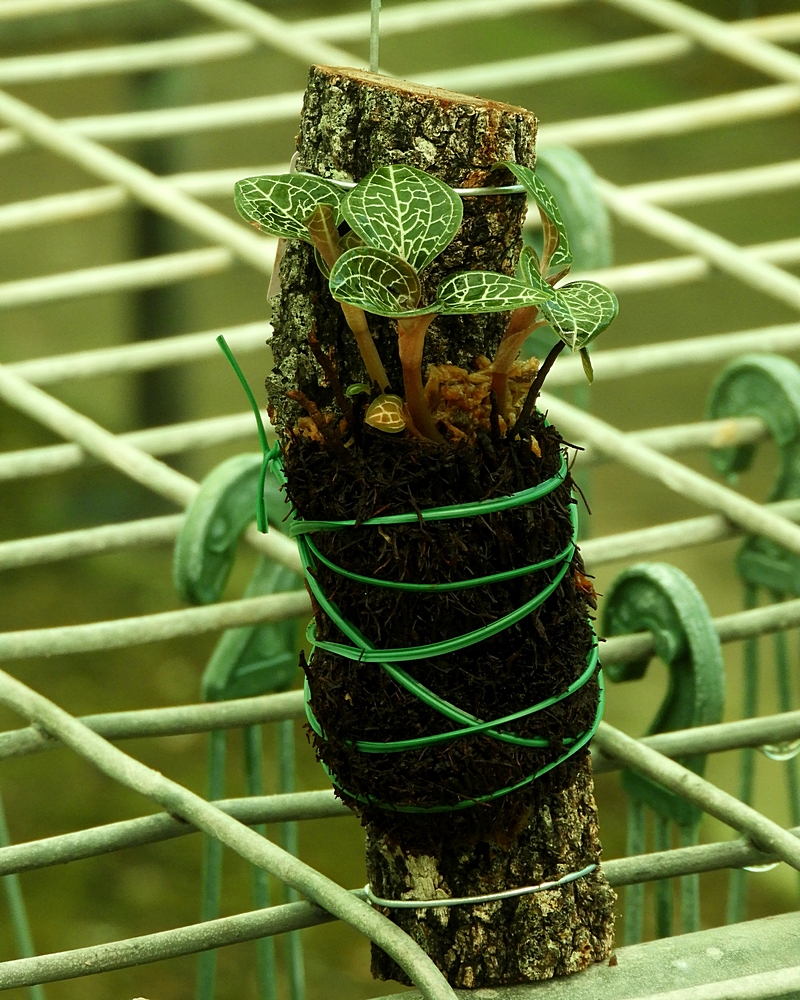
The flasks arrive; Well, you've finally got your hot little hands on that hard to get orchid at long last. Only trouble is, it's in a bottle, and how do you get it out of that and flowering in a six inch pot?? Not so easily as you would hope.
It is important that you DO NOT deflask seedlings too quickly after you receive flasks. The flasks should be allowed to acclimatise and the seedlings grow.
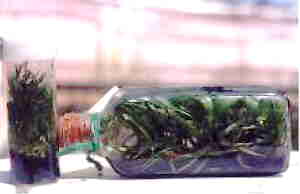
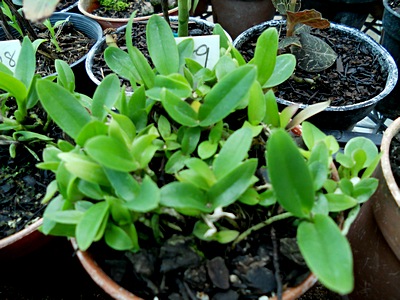 The little babies are fragile and delicate, so check the bottle to see if they are big enough to come out.
If not, place the flask in a well lighted area, near a southern or northern window, but out of direct sunlight which will cook the seedlings.
The little babies are fragile and delicate, so check the bottle to see if they are big enough to come out.
If not, place the flask in a well lighted area, near a southern or northern window, but out of direct sunlight which will cook the seedlings.
If flasks arrive shaken up, gently tap the flask until the seedlings are sitting on top of the media, then allow the flask some time to acclimatise and the seedlings will continue to grow.
Even flasks badly shaken should be gently tapped to get seedlings on top and left alone until seedlings start growing again. There is usually no need to deflask immediately, and seedlings are best left to stabilise and usually will continue to grow.
Harden off and prepare
When the seedlings are large enough for you to handle, harden them off by placing the flask under about 90% shade, DRY, for several days. Again, closer to a window for the extra light will do.
Prepare your work area with a sheet of clean newspaper on the bench. Make sure the pot is clean, and the potting media is sterile.
Which mix? A mixture of fine bark and shredded polystyrene(isolite), 4 parts bark to 3 parts polystyrene has given excellent results. If your conditions are dry, add half a part shredded spaghnam moss or perlite to the mix.
Spaghnam moss is used by a lot of experienced growers, but locally (Townsville, Nth.QLD.), it tends to break down rapidly. Peat moss should be sterilised wet in an oven bag, 10 minutes in the microwave, if perlite and peat moss is your choice.
The biggest danger to flask seedlings is soil and water borne pathogens, so keep everything clean.
Deflasking method 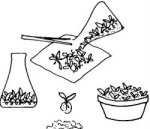 Remove the seedlings from the bottle, either by washing them out or breaking the bottle. Wash the seedlings in warm water, not cold, so that all agar gel is removed.
Remove the seedlings from the bottle, either by washing them out or breaking the bottle. Wash the seedlings in warm water, not cold, so that all agar gel is removed.
Place the seedlings on a clean sheet of newspaper and allow to dry to dampness. With a small pot well crocked, pot the seedlings together into a community pot.
They like to be together, and will do better this way than potted singly. About an inch of potting media is all that is required.
Coryanthes and Cymbidiun
canaliculatum. ( See alternative method top of page) Because these species vine in the flask ie produce long
spindley seedlings, they need to be compotted all together. Do not pot separtely. Plant deep in the community pot with the tops showing.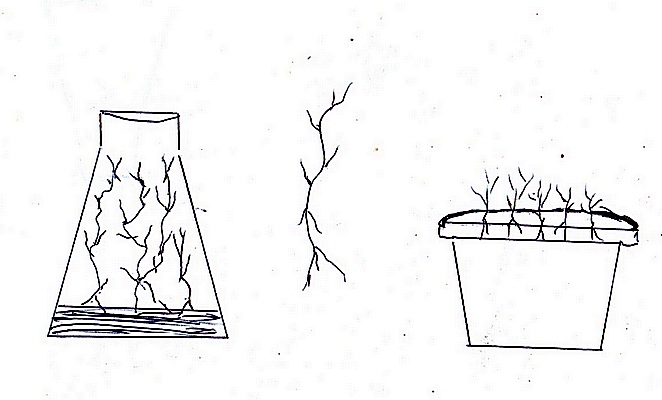 When seedling plantlets have developed into stronger plantlets, recompot with
the developed plantlets sitting on the media. ( In the wild these species
germinated deep in hollows and vine their way to sunlight.)
When seedling plantlets have developed into stronger plantlets, recompot with
the developed plantlets sitting on the media. ( In the wild these species
germinated deep in hollows and vine their way to sunlight.)
Rogers deflask method for Coryanthes. Spread the long
spindley seedlings out on a thin bed of spaghnam moss. Trick is
not to cover the stoloniferous growths, they are very prone to rot. I just place
them onto a barely moist sphagnum bed. They then put out
roots along the growth and eventually form the growths which grow very fast.
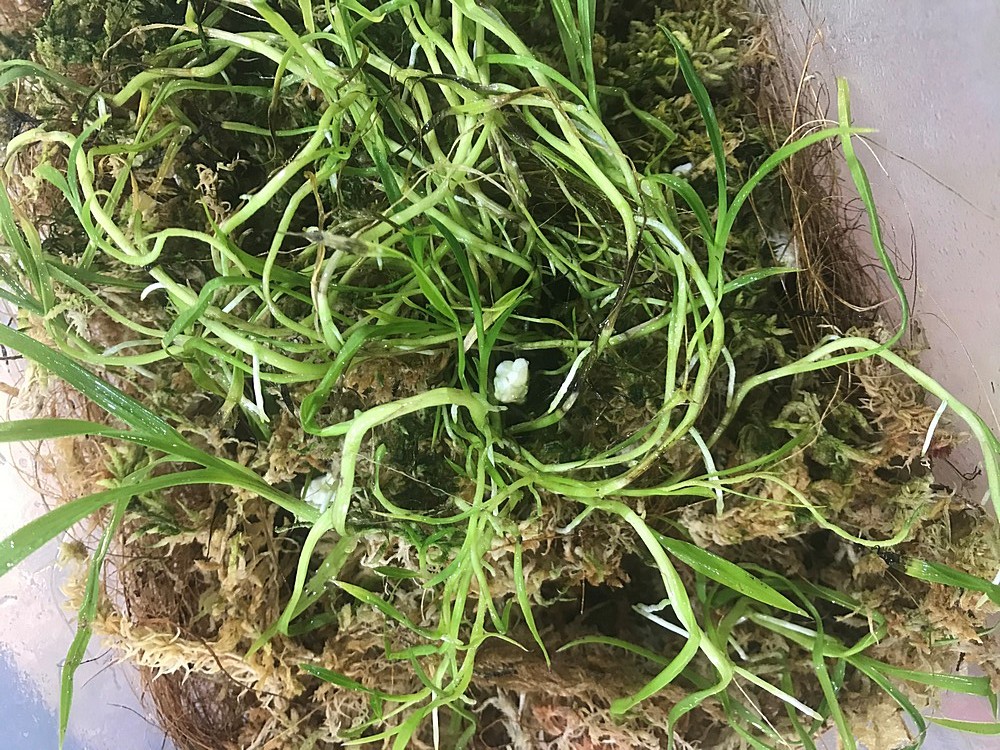 ... ...
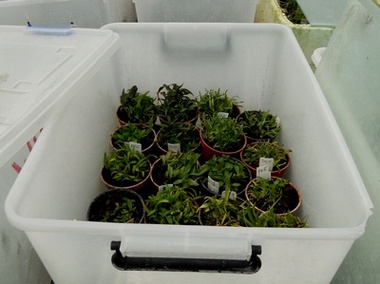
Initial care
Water the pot well, and allow to drain. There is a product called "Envy", which can then be sprayed onto the seedlings. This coats the leaves and helps prevent the seedlings drying out. It is an aid, not an essential. To protect the seedlings, it is a good idea to use a humidity crib.
A translucent plastic storage box from the discounters works well, the lid progessively moved off.
Seedlings can die from Too Much Water. For the next few days, very lightly mist the leaves. Keep the seedlings in heavy shade.Frequent light misting will prevent dehydration and encourage new root growth, without keeping the media wet. After a few days, the cover can be partly removed and the seedlings watered so that they are just damp but not wet. Hormone formula and very weak fertiliser can then be used, and as the seedlings establish, the cover can be removed altogether.
The importance of ventilation
For the first couple of weeks, fungicides should not be used on the seedlings, as it has a growth inhibiting effect . If there is a problem with fungus or mould, it means the conditions are too wet, so cut water, ensure ventilation is sufficient, and let the seedlings dry out a bit. In fact, most fungus problems in an orchid house can be fixed by reducing water and increasing ventilation.
Growing on
Once the seedlings are established and grown to their second lead or new larger leaf, they can be potted singly into small pots. One local orchid grower whom I wont mention, leaves several seedlings in the one pot (or basket), and when Alf Steel's Barkerias flower, there is an instant specimen display.
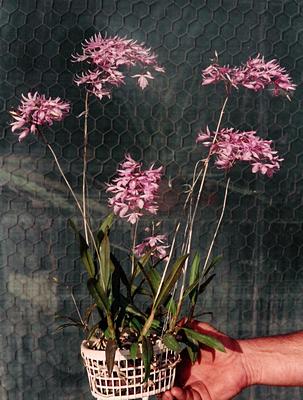
Growing seedlings from flask is a techinique to be learned,and once mastered, can be very rewarding, especially when YOUR babies start to flower. Text by Ian Walters.
May be reproduced provided source acknowledged.
|


 The little babies are fragile and delicate, so check the bottle to see if they are big enough to come out.
If not, place the flask in a well lighted area, near a southern or northern window, but out of direct sunlight which will cook the seedlings.
The little babies are fragile and delicate, so check the bottle to see if they are big enough to come out.
If not, place the flask in a well lighted area, near a southern or northern window, but out of direct sunlight which will cook the seedlings. Remove the seedlings from the bottle, either by washing them out or breaking the bottle. Wash the seedlings in warm water, not cold, so that all agar gel is removed.
Remove the seedlings from the bottle, either by washing them out or breaking the bottle. Wash the seedlings in warm water, not cold, so that all agar gel is removed. When seedling plantlets have developed into stronger plantlets, recompot with
the developed plantlets sitting on the media. ( In the wild these species
germinated deep in hollows and vine their way to sunlight.)
When seedling plantlets have developed into stronger plantlets, recompot with
the developed plantlets sitting on the media. ( In the wild these species
germinated deep in hollows and vine their way to sunlight.) ...
...
